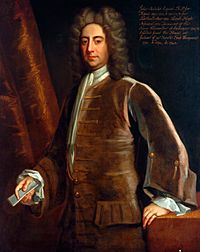John Aislabie facts for kids
Quick facts for kids
John Aislabie
|
|
|---|---|
 |
|
| Chancellor of the Exchequer | |
| In office 20 March 1718 – 23 January 1721 |
|
| Monarch | George I |
| Preceded by | The Viscount Stanhope |
| Succeeded by | Sir John Pratt (interim) |
| Personal details | |
| Born | 4 December 1670 |
| Died | 18 June 1742 (aged 71) |
| Nationality | British |
| Political party | Whig |
| Alma mater | St John's College, Cambridge Trinity Hall, Cambridge |
John Aislabie (born December 4, 1670 – died June 18, 1742) was an important British politician. He lived at Studley Royal, a large estate near Ripon in Yorkshire.
John Aislabie was a Member of Parliament for many years, from 1695 to 1721. He was known for having his own ideas and didn't always stick to one political group. He held a very important job as the Chancellor of the Exchequer, which means he was in charge of the country's money. This was during a famous financial event called the South Sea Bubble. His involvement with this company led to him leaving his job and facing serious consequences.
Contents
Early Life and Education
John Aislabie's family were originally farmers from a place called Hemingbrough. His father, George Aislabie, married Mary Mallory. Her family was very influential and owned the Studley Royal estate.
John went to St Peter's School, York and later studied at St John's College, Cambridge and Trinity Hall, Cambridge. In 1693, he inherited the Studley estate from his mother's family.
Creating the Studley Royal Water Garden
John Aislabie began to develop the gardens at Studley Royal around 1716. He was one of the first people in England to create a natural-looking landscape. He designed the beautiful water garden at Studley Royal.
Later, his son, William Aislabie, added the famous ruins of Fountains Abbey to the estate. This made the gardens even more special.
A Career in Politics
John Aislabie became a member of parliament for Ripon in 1695. At first, people thought he was a Tory, which was one of the main political groups. However, his political ideas sometimes changed.
He was re-elected for Ripon many times. He became more active in politics from 1704, especially focusing on the country's economy. He eventually became linked with the Country Whigs, another political group.
Important Roles in Government
With the support of Robert Harley, John Aislabie was appointed a Lord of the Admiralty in 1710. This job involved managing the navy. Even though he was in a Tory government, his Whig ideas sometimes meant he voted against the government.
When the Whigs came back into power in 1714, Aislabie was made Treasurer of the Navy. He became a close friend of the Earl of Sunderland, who was like the Prime Minister at the time. Sunderland then made Aislabie the Chancellor of the Exchequer in 1718. This was a very important role, managing all the country's money.
The South Sea Bubble
In 1719, a company called the South Sea Company made a big offer. They suggested they could take over the country's national debt. John Aislabie strongly supported this plan and helped create the agreement. He guided the new law through the House of Commons.
However, the South Sea Company had promised too much and couldn't deliver. It failed in August 1720. An investigation by Parliament found that John Aislabie had received company stock in exchange for his support of the plan.
He resigned from his job as Chancellor of the Exchequer in January 1721. In March, Parliament found him responsible for serious problems related to the company. He was removed from Parliament and lost his position on the Privy Council. He faced serious consequences for his actions.
Life After Politics
After leaving his political roles, John Aislabie went back to his estate. He continued to work on and improve his famous gardens.
Other Contributions
John Aislabie also contributed to his local town. In 1702, he provided the Ripon Obelisk in the Market Square in Ripon. This was the first obelisk of its kind in England and is now a protected historical monument.
In 1723, Aislabie built Waverley Abbey House in Surrey. This house was built on the site of an old Cistercian monastery called Waverley Abbey.
John's son, William Aislabie, also became a Member of Parliament for the Ripon area, following in his father's footsteps.
|


